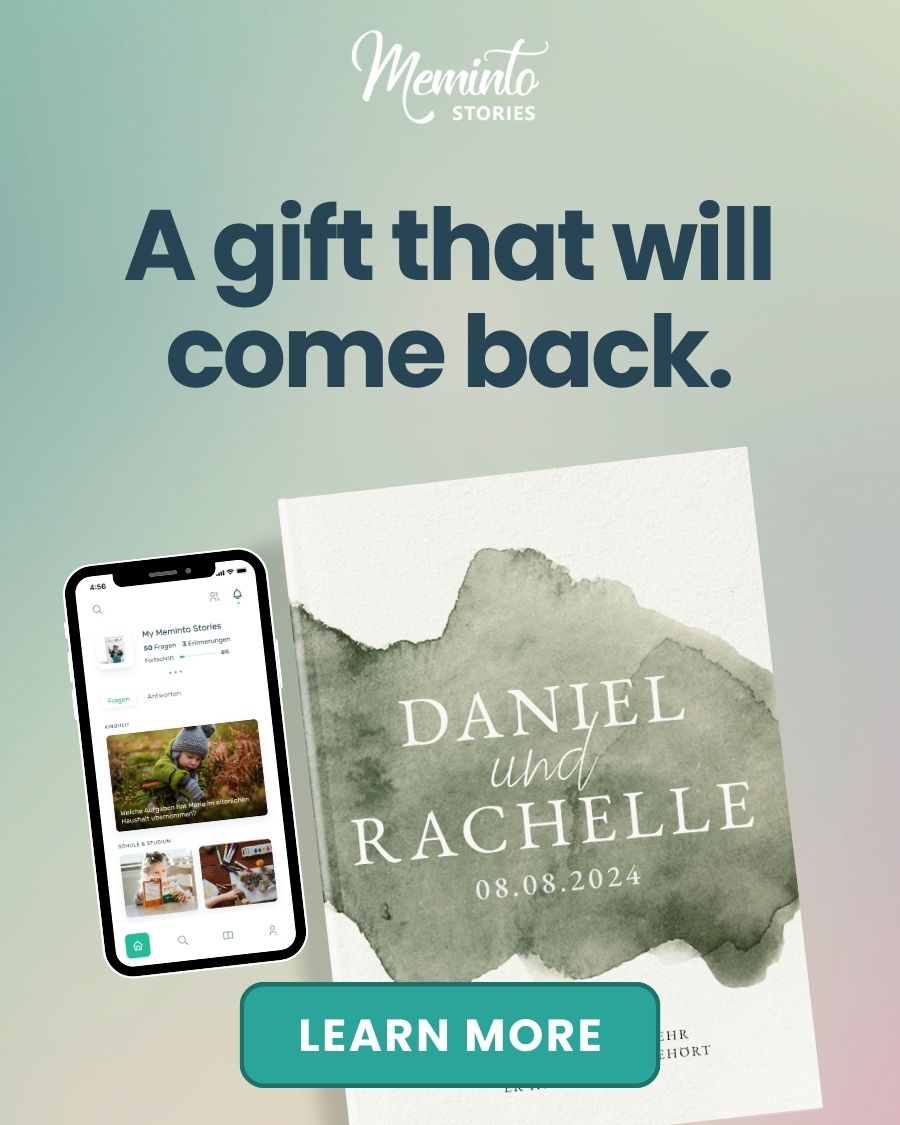Your family’s history doesn’t belong in dusty boxes, it belongs in a story you can pass down. Think about your grandmother who immigrated with nothing but hope, or your father who built a business from scratch. These aren’t just personal anecdotes; they’re chapters in your family’s unique story.
Currently, your family’s stories are locked away in shoeboxes and interrupted conversations. When your parents are gone, those half-finished stories at dinner will be gone too. A family memoir captures these moments before they disappear forever.
In this guide, you’ll discover a proven step-by-step process for capturing your family’s essence. You’ll learn exactly how to turn scattered memories into stories your grandchildren will want to read.
Key takeaways
- Family memoirs reveal intergenerational patterns that individual stories often overlook, as they show how traits like work ethic or resilience can pass through generations when multiple voices share their perspectives.
- Start with one willing storyteller who lived through significant transitions and isn’t afraid to share the messy parts, rather than trying to capture everyone’s story at once.
- Organize your family’s stories by recurring themes, such as “starting over when things fall apart” or “finding humor in tough times,” rather than following a chronological timeline.
- Include vulnerable moments and specific details because the uncomfortable parts and concrete descriptions make stories relatable and memorable for future generations.
- Use Meminto to create your family memoir book and use our guided prompts to get started with uncovering meaningful stories.
Why family memoirs matter more than individual stories
Sure, your mom could write her memoir. However, individual stories only reveal one aspect of your family’s journey. A family history memoir connects the dots between generations, revealing patterns that shape who you are today.
Shows intergenerational themes
When you only hear one side of a story, you miss the bigger picture.
Your dad might say he’s “always been a hard worker.” However, when you interview your grandfather, you discover that his work ethic stemmed from losing everything during the Great Depression and his vow never to be helpless again.
Suddenly, your father’s 60-hour weeks make sense. And maybe your drive to save money clicks into place.
These patterns repeat across generations, but they become visible only when multiple voices share their perspectives. As Viktoria from Switzerland put it after creating books with her son: “We recorded almost a century of history,” something that would have been impossible with just one person’s story.
Builds identity
Psychologists at Emory University found that kids who knew their family stories scored higher on measures of self-esteem and had better coping skills during tough times.
But it’s not about knowing facts like birth dates and job titles. It’s about understanding the character traits that have been passed down through your family line.
When your daughter knows her great-grandmother started a bakery with borrowed flour during the Depression, that story becomes part of her identity. She carries that scrappy entrepreneurial spirit in her bones; the same drive that made her start a lemonade stand at age 7 and negotiate her allowance like a business deal.
Like Werner said about his memoir project: “A memoir like this also clarifies things for oneself.” The stories don’t just preserve history; they help us understand who we are and where we come from.
Preserves wisdom
Individual memoirs tell you what happened. Family memoirs reveal what your family learned from what happened.
Your uncle’s story about losing the family farm isn’t valuable because farms were lost. It’s useful because it shows how your family handles failure.
Does your family retreat and play it safe? Or do they dust themselves off and try something new? That wisdom only emerges when you connect his story to how your aunt bounced back from divorce, or how your cousin recovered from bankruptcy.
The pattern teaches the lesson.
Step-by-Step family memoir writing plan
Ready to turn those scattered stories into something your family will treasure? Most people get overwhelmed because they try to capture everything at once.
Start small and build piece by piece. Jost from Germany figured this out when his daughter asked him to write about his youth: “I came across Meminto. It’s a great way to write everything down.”
Here’s how to tackle writing family memoir without losing your mind.
Step 1: Choose a storyteller
Don’t try to be the hero who captures everyone’s story. Pick one family member to focus on first.
Look for someone who lived through the integration of schools, survived a natural disaster, started a business during a recession, or was the first in the family to go to college. Perhaps it’s your grandmother who immigrated, your father who founded the family business, or your aunt who raised children as a single mother.
The best storytellers aren’t always the oldest. They’re the ones who remember details and aren’t afraid to share the messy parts. As Barbara from Germany learned when working on her mother’s story: “We made a lot of audio recordings. Now I listen to it from the book every time I miss her.”
Start with whoever’s most willing to talk. You can always add other voices later.
Step 2: Interview & record audio
Sit down with your chosen storyteller and hit record. Your phone’s voice recorder works perfectly for this.
The goal isn’t professional-quality audio; it’s capturing their actual voice and the way they naturally tell stories. Begin with easy questions, such as “What’s your earliest memory?” or “Tell me about the house you grew up in.” Let them ramble and go off on tangents because the best family stories usually surface when people are talking about something else entirely.
Don’t worry about getting everything perfect in one sitting. Plan for multiple sessions because people tend to get tired, and different memories emerge on different days. Some stories need time to marinate before they’re ready to be shared.
Once you have your recordings, you’ll need to get them transcribed. Richard from the UK found this part easier than expected: “I recorded my entire book, and Meminto transcribed it. It was simple and still led to something remarkable.” You can use transcription services or apps to turn those hours of audio into text you can work with.
When you listen back to these recordings later, you’ll catch details and emotions that you missed the first time around.
Step 3: Organize themes (love, migration, sacrifice)
Now you’ve got hours of transcribed interviews, and it probably feels like a jumbled mess. That’s normal.
Instead of trying to organize everything chronologically, look for the recurring themes that keep appearing in your family’s stories. Most families have three or four major themes that run through generations like invisible threads.
Maybe your family’s theme is ‘we always help each other move’ (literally every cousin, every apartment, every time), or ‘we marry people who make us laugh’, or ‘we never throw away anything that might be useful someday.’
Your grandfather’s immigration story may have some connection to your father’s career moves and your own decision to relocate for work. Your grandmother’s wartime sacrifices might echo in how your mother managed single parenthood or how you handle your challenges.
Read through your transcripts and highlight stories that fit together thematically rather than chronologically. You might discover that your family’s theme isn’t just “hard work” but specifically “starting over when things fall apart.” Or maybe it’s “finding humor in tough times” or “putting family first, no matter what.”
These themes become the backbone of your family storybook because they show the deeper patterns that make your family unique.
Step 4: Draft story arcs
Now that you’ve organized your themes, it’s time to turn those scattered stories into actual narratives that flow together.
Think of each theme as its mini-story with a beginning, middle, and end. Your family’s migration theme might start with your great-grandparents leaving their homeland, continue through the struggles of establishing themselves in a new country, and conclude with how that brave decision shaped generations of risk-takers in your family.
Don’t write everything chronologically from birth to death. Instead, focus on the moments that changed everything. Your grandmother’s story might center around the day she decided to leave an abusive marriage, or your father’s arc might revolve around the choice to sell the family business and start over.
Look for turning points, difficult decisions, and moments of growth within each theme. These become the backbone of your story arcs. Maria from Germany discovered this approach worked beautifully: “Thanks to Meminto’s insightful questions and prompt support, my story flourished into over 300 pages across two volumes.”
Each story arc should reveal something important about your family’s character and values. The goal isn’t to document every detail, but to capture the essence of how your family navigates life’s biggest challenges and celebrations.
Step 5: Add visuals and keepsakes
Your family memoir isn’t just words on a page. It’s a living document that brings stories to life with the photos, letters, and objects that carry meaning.
Dig through those shoeboxes and photo albums you’ve been avoiding. Look for pictures that match your stories, but don’t just grab the obvious ones. Sometimes, the candid shots of your dad fixing a car or your grandmother in her garden tell better stories than formal portraits.
Scan old letters, recipes written in your great-aunt’s handwriting, immigration documents, or that faded business card from your grandfather’s shop. These artifacts add texture and authenticity that pure storytelling can’t match. They’re proof that these people lived whole, complex lives beyond the stories you’re telling.
JP and Michelle from South Africa understood this power: “Our favorite feature is that you can add a video memory in your book! How amazing is that!? This truly sets Meminto apart.” Modern technology lets you include audio clips of your grandmother’s laugh or a video of your father explaining how to fix an engine.
Don’t obsess over perfect organization. Sometimes the most powerful visuals are the unexpected ones that capture a moment you never knew existed.
Overcoming common family memoir challenges
Let’s be honest about family memoir projects. They don’t always go smoothly. People get weird about sharing stories, memories don’t match up, and sometimes you hit dead ends where information just doesn’t exist anymore.
Here are the roadblocks you’ll likely face and how to navigate them without losing your composure:
1. Resistance from family members
Some relatives will clam up the moment you mention recording their stories. They’re worried about privacy, judgment, or “airing dirty laundry” to future generations.
Start small and non-threatening. Instead of asking for their life story, ask about a specific object or photo. “Tell me about this picture of you and Dad at the lake.” Once they start talking and realize you’re not trying to expose family secrets, they usually warm up.
Steven from Los Angeles faced this challenge when working on his late brother’s stories. “I am extremely happy that I was able to preserve my late brother’s stories and poems with Meminto before they are forgotten.” Sometimes the resistance comes from grief or the feeling that certain stories are too personal to share.
2. Missing information and lost details
You’ll encounter gaps where nobody remembers important dates, names, or key events that occurred during significant family moments. It is frustrating, but not a project killer.
Focus on what you do know and acknowledge what’s missing. “We’re not sure exactly when Grandpa started his business, but we know it was sometime after the war when materials became available again.” Sometimes the mystery itself becomes part of the story.
3. Conflicting memories
This is the big one. Two people recall the same event in completely different ways, and both insist they’re right.
Don’t try to play detective and figure out who’s “correct.” Include both versions and let readers understand that memory is a subjective phenomenon. “Dad remembers the store being busy from day one, but Mom says it took months to build a customer base. Either way, they both agree it required long hours and determination.”
These conflicts often reveal more about your family dynamics than a single “accurate” version ever could.
What makes a family memoir worth reading
Nobody wants to read a boring family history that sounds like an obituary stretched over 200 pages. The difference between a memoir people treasure and one that sits on a shelf gathering dust comes down to four things.
1. Vulnerability
The best family stories include the uncomfortable parts. Your grandfather wasn’t just a “hard worker” who “provided for his family.” He was probably also stubborn, maybe had a temper, and made mistakes along the way.
Anja from Germany understood this when creating her memoir. “I felt well taken care of by Meminto. They made me feel like my project was just as important to them as it was to me.” The stories that mattered most weren’t the perfect moments, but the real ones where people struggled and figured things out.
Don’t sanitize your family’s story. Include the divorces, the business failures, the times people didn’t speak to each other for years. These human moments make your family relatable, rather than untouchable.
2. Humor
Families develop their weird sense of humor over the years. That inside joke about your uncle’s terrible cooking or the way your grandmother mispronounced certain words becomes part of your family’s personality.
Capture these moments because they show how your family handles life’s absurdities. Willi from Germany got this right when he wrote his memoir, “mainly as a keepsake for my grandchildren and great-grandchildren. Not only was it a breeze to do, but it was a lot of fun.”
3. Detail
Generic statements like “times were hard” or “we were close” don’t convey much meaning. Specific details bring stories to life and help readers feel like they were there.
Instead of “Grandma was a good cook,” write “Grandma made bread every Tuesday morning, and you could smell the yeast rising from three houses away. She’d save the first warm slice for whoever was willing to churn butter.” The details make the difference.
4. Truth told with compassion
Be honest about your family’s flaws without being cruel about them. There’s a difference between acknowledging that your father struggled with drinking and making him the villain of every story.
Present people as complex humans who made both good and bad choices within the circumstances they faced. This approach fosters understanding rather than judgment across generations.
Create your family’s living legacy
Your family’s stories won’t preserve themselves. Every day that passes, another memory fades or gets distorted in the telling.
Families who complete their memoirs start small and stay consistent. Werner from Germany proved this works: “With just one question per week, I was able to record my life story. That was a lot of fun!” Consider trying Meminto’s approach, which involves guided questions that make the process feel manageable rather than overwhelming.
Your parents won’t be around forever to answer these questions. Download our family memoir roadmap PDF + interview prompts that uncover the stories your kids will want to hear; these are the exact template that helped Maria turn scattered memories into 300 pages of family treasures.

















